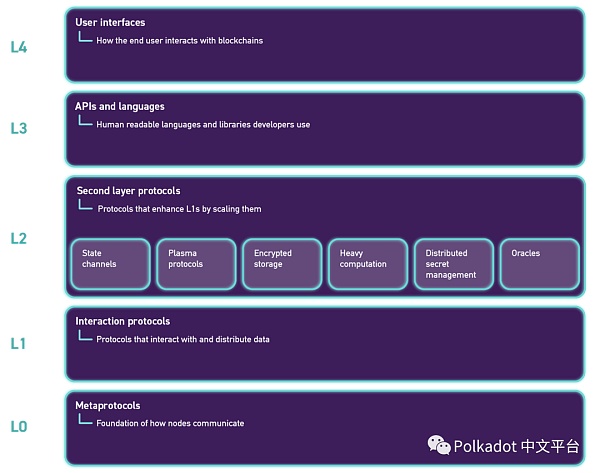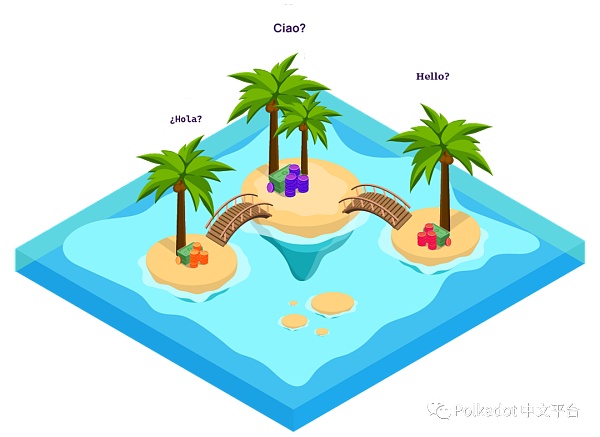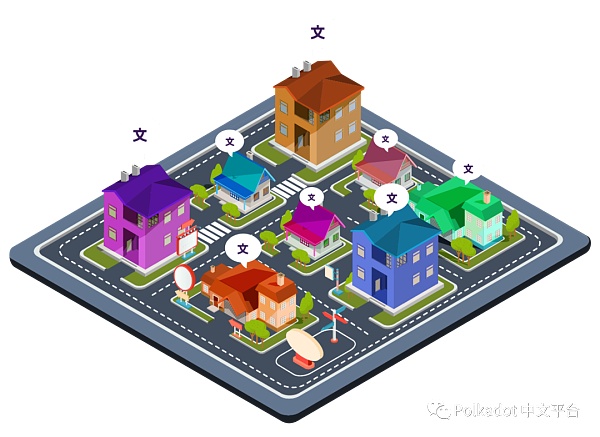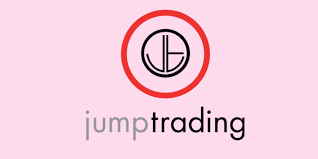Why is Polkadot called Layer 0?
Why is Polkadot Layer 0?Polkadot is a platform for interconnected blockchains, which calls itself a meta-protocol or “layer zero” in its technology stack. This term is not widely used or understood, especially by those who have not taken the time to study Polkadot. In this article, we will explore the concept of layer zero blockchains and the importance of this approach in defining the next generation of cryptographic networks.
What is a layer?
Blockchain architecture has different parts, each with a unique purpose designed to work in concert. Each part can be thought of as a layer. Web3 technology is built in layers for security and scalability, which requires a combination of different protocols and functionalities to work together. This is called a technology stack.
The blockchain starts with a genesis block and adds to the blockchain by creating blocks on top of it. New transactions will change the data stored in each new block, which also includes a digest of the data stored in the previous block, ensuring that everything is interrelated. The decentralized consensus mechanism ensures that every transaction and block is valid.
- Ten Questions About the Metaverse: Is There Still Hope for Virtual Land?
- Analysis of Binance’s new coin investment returns: What are the reasons behind the poor performance?
- Understanding the Opside ZK-PoW Algorithm Mechanism and Potential: How to Improve ZKP Generation Efficiency by 80%?
This structure makes the chain secure and transactions immutable, but it also slows down the process when there are many demands on the chain. Blockchain layers can be used to scale by separating each component of the entire blockchain architecture so that each component can be optimized and developed separately. Scaling means building in a way that allows the blockchain to do more work while still maintaining security.
According to the Web3 Foundation, which supports Polkadot and Kusama, the Web3 technology stack has four layers. Typically, the scope of blockchain layers ranges from layer zero (the deepest foundational layer) to layer four (the interface that users interact with).
Let’s take a look at what the Web3 Foundation means by positioning Polkadot as a layer zero and how it will seek out users for the platform.

So… is Polkadot Layer 1?
No, Polkadot is not a Layer 1 blockchain. Polkadot is considered a layer zero blockchain because it serves as a “meta-protocol” for deploying other layer one (smart contract platforms and specific application blockchains).
Overview of Polkadot Layer Zero
Describing Polkadot as layer zero (L0) helps to understand what layer one (L1) is, as L1 is more familiar. The term layer one describes a trustless or low-trust interaction protocol, such as the most well-known blockchains (e.g. Ethereum, Avalanche, Moonbeam). L2s like Arbitrum and L0s like Polkadot are also blockchains.
Layer one blockchains support various applications such as DeFi and NFT marketplaces, while L0 supports L1 blockchains. L2s, L3s, and L4s are built on top of L1s and build on each other. Therefore, L0 is not a blockchain that builds things, but a blockchain platform that provides secure infrastructure for other blockchains (such as L1).
The layer 0 blockchain is the foundation of a technology stack composed of communication protocols. It is the lowest level of programming that sets standards or starting points for L1 blockchains in a way that optimizes security and interoperability. This compatibility is possible because L0 provides a common language for all connected chains.
The end user almost never interacts with this layer in the stack, as L0 itself does not perform work in this way. It provides tools for L1 blockchains to do the work. For example, Polkadot does not host smart contracts, but provides tools so that “parachains” (L1s on top of Polkadot L0) can build and offer smart contracts.
Polkadot is layer zero because it is a low-trust interaction platform for parachains. As an interoperability protocol, Polkadot provides security for parachains through consensus. Due to this architecture, Polkadot allows blockchains to exchange messages and execute transactions without the need for additional third parties, as layer 0 already fulfills this purpose. Polkadot itself only performs the minimum functions, including security, staking, and governance.
Layer one (L1) blockchains are responsible for data distribution and interaction. In the Polkadot ecosystem, L1 blockchains improve upon the underlying layer of Polkadot itself. As the blockchain ecosystem evolves, L1 can also extend other L1s. Parachains need Polkadot, and Polkadot needs parachains: Polkadot provides security and connectivity, but activity occurs at the smart contract level on the parachain.
The end user typically does not interact directly with L1s like Ethereum, Avalanche, and Moonbeam, but rather uses native network tokens to pay transaction fees when using these DApps. Users interact with L1s through dApps built on top of L1s, for example, while end users do not interact directly with Moonbeam itself as a smart contract platform, they can still use GLRM tokens to pay transaction fees or use GLMR in DeFi on top of L1. The name of the L1 blockchain is familiar, but the end user interacts with applications built on top of L1s, not L1 itself.
Layer 1 (L1) can provide different functionalities or have different priorities, such as smart contract platforms, DeFi, or storage. At this layer, developers work within the basic L0 (or L1) framework, designing protocols to accomplish tasks. L1 utilizes core protocols such as EVM and WASM but adds features that allow developers to interact with and build on L0.
Why Layer 1 Needs Layer 0
Layer 0 blockchain protocols provide solutions to some of the challenges encountered by standalone Layer 1 blockchains. Layer 0s like Polkadot provide security and other tools for all parallel chains so that they can focus on developing blockchains for specific purposes or applications that can locally interoperate within the same consensus (Polkadot).
Historically, Layer 1 (L1) blockchains were isolated from each other, which presented challenges: they operated independently and were responsible for everything they needed, including security, and they were often general-purpose blockchains that couldn’t be optimized to efficiently address specific problems. Providing security for a blockchain and building everything it needs to run is a burden for developers working at Layer 1 and may come at the expense of quality service. Additionally, overloaded blockchains running many different systems can be slow and expensive in transaction fees.
Layer 1 blockchains may want to access users, information, and tokens from other blockchains to help scale or grow. Traditionally, the only option was to use a bridge to connect to another chain with more users or liquidity. Some bridging options are available to connect L1 blockchains, but these solutions are limited and sometimes unreliable.
Many of these issues are addressed when Layer 1 blockchains connect to Layer 0 protocols like Polkadot or Kusama. Conversely, Layer 0 cannot do its job without Layer 1 blockchains built on top of it. Polkadot exists independently, but derives value from the parallel chains that use the tools it provides to solve specialized use cases or offer meaningful end-user applications.
The Current State of Blockchain Layers: L1 as an Island
Most chains are standalone, apart from Kusama and Polkadot parallel chains–meaning they manage their own security and everything else. Ecosystems like Cosmos have hubs that serve similar purposes, but are architecturally different from Polkadot.
Imagine these independent L1 blockchain networks as islands:
-
Each has its own language and currency, and each community manages itself.
-
Bridges can be built to connect the islands, but many factors can affect the stability and use of these bridges.
-
Communities from different islands may speak different languages and have different customs, making interaction complex.
-
Moving items between islands may be restricted when traveling along the bridges.
-
Communication and movement between islands is possible, but can be difficult and unreliable at times.

Polkadot can securely connect parallel chains without the need for a bridge. As an L1 based on Polkadot’s L0 blockchain, a parallel chain is like a house connected by roads in the Polkadot community.
-
In the Polkadot community, the roads are shared secure communication channels between blockchains that can be used for governance and other means. Polkadot is like a government that maintains roads and captures bad actors (like the police).
-
Everyone in the community speaks the same language and follows larger community rules to ensure everyone’s safety.
-
Each parallel chain family can freely establish their own house rules.
-
Parallel chains can establish shortcuts to neighboring houses, and they hope to directly access other parallel chains through the “roads” provided by Polkadot.

Polkadot’s relay chain is like the foundation below L1 blockchains, securely connecting them and allowing them to share the security of the entire ecosystem. Communication between blockchains is provided by Polkadot protocols such as XCMP. XCMP is a cross-consensus message passing protocol developed by Polkadot that is used by parallel chains and can also be extended for use with external blockchains.
In this analogy, Polkadot would be the foundation on which the parallel chains run, just like the land on which the parallel chain communities are located. Polkadot maintains roads and other infrastructure, so families don’t have to do it themselves.
Polkadot is a decentralized infrastructure that securely connects parallel chains to allow for simpler and more reliable movement between them. These connections are direct and can accommodate a variety of payloads. You can move bi-directionally, carrying heavy or oddly shaped items (such as data, NFTs, and tokens) without being affected by weather conditions, traffic, or the stability of the blockchain itself.
Polkadot is designed as a large community, so parallel chains work together for the benefit of the entire ecosystem, as they all benefit from more security and cross-chain interoperability options, while maintaining their sovereignty through their own tokens, validators, and governance.
Polkadot as an Interoperability Hub
Polkadot seeks to facilitate a truly decentralized blockchain internet, with these blockchains interconnected natively as underlying layers that support Layer 1. This means that although L1 blockchains on Polkadot can manage, build, and maintain any functionality they want, they are connected by Polkadot’s relay chain. This native interconnectedness brings the following benefits:
Scalability
There are no smart contracts on Polkadot; instead, all smart contracts exist on the parallel chains. This allows Polkadot to focus freely on message passing and security, while letting parallel chains act as scalable solutions.
Specialization
Polkadot itself is only concerned with its foundational work as a zero layer. Allowing protocols like L1 blockchains to specialize makes parallel chains heterogeneous. Other L1 blockchains have to balance their security and use DApps for scaling, but Polkadot and its dedicated blockchains (parallel chains) work together.
Each parallel chain can independently customize its design to optimize for specific use cases or applications. This allows teams to focus on their goals without having to spend energy on other aspects of blockchain technology, such as security. This means that although interconnected, parallel chains can focus on one function, such as storage, privacy, or smart contracts, and do it better than if you had to maintain their security (as well as storage, privacy, and smart contracts).
Interoperability
Since all parallel chains are built on a framework called Substrate and connected to Polkadot’s architecture, they can communicate locally, trade assets, and form rich cross-chain interactions and connections. Polkadot’s XCM (cross-consensus message passing) format, with XCMP functionality, allows parallel chains to interact with each other (without using the relay chain) to share assets, among other things.
No Forking Upgrades
All runtime upgrades are conducted via on-chain public voting, so there are no rogue factions running alternative versions of the chain. On Polkadot, code is law and enforced via on-chain voting.
Cross-Chain Smart Contracts
The latest upgrades to Polkadot and L1 Moonbeam have taken interoperability within the Polkadot ecosystem to new heights. Associated Contracts leverage the security of the relay chain and use Polkadot’s XCM and external generic message passing to communicate across remote blockchains. This capability extends the interoperability of parachains to external independent blockchains like Ethereum, Avalanche, and Cosmos.
Cross-chain applications enable a shift towards availability by allowing end-users to combine any token with functionality from any blockchain, all within the context of a single application user experience. The readily available nature of this inter-blockchain communication will change the development of Web3 by producing more efficient protocols with exceptional user experiences.
Why Build on Polkadot Layer 0
Building Layer 1
In the context of the Web3 technology stack, Polkadot has become a notable example of Layer 0. Layer 0 is the foundation of the stack and includes how blockchains communicate and how they are programmed at the lowest level. As blockchain technology evolves, new use cases and possibilities for interoperability and communication emerge. As user adoption increases, Solo chains face new challenges, making ecosystems built to manage these developments more attractive.
Although it was created after layers such as Bitcoin and Ethereum, Polkadot and its parachains introduce a critical foundational component that will become the structure for Web3’s interoperable future.
We will continue to update Blocking; if you have any questions or suggestions, please contact us!
Was this article helpful?
93 out of 132 found this helpful
Related articles
- Decentralized Storage Rising Star Datamall Chain Unique Mechanism Explained
- Metropolitan Museum of Art in New York to return $550,000 FTX donation
- OP Research: The Meme Coin Craze is the Ultimate Expression of Herd Mentality
- Analysis of Binance’s New Coin Investment Returns: The Exclusive Curse of Top 1
- Foresight Ventures: Rational View of Decentralized Computing Power Network
- How can Google’s StyleDrop compete with the AI drawing tool Midjourney?
- LD Capital: Analysis on Customized DEX Mechanism for L2 Top-tier Liquidity






